Kaustubh Pandey writes in detail about why Liverpool struggle against defensive teams.
It has increasingly become a rather usual sight to see Jurgen Klopp’s Liverpool drop points regularly against a side that doesn’t belong to the top six. While, it clearly isn’t something that is supposed to happen with a club that has ambitions of winning the Premier League, but the regularity of it has made Liverpool fans expect a bottling whenever their side comes up against a smaller side. Be it Crystal Palace, Bournemouth, Sunderland or Southampton, the Merseysiders have failed to pick up all three points from games that a side like them just have to win.
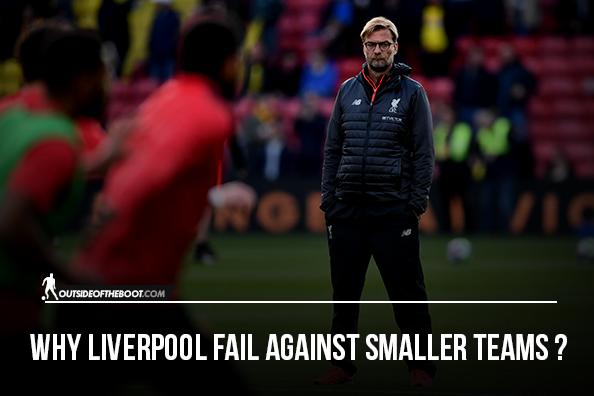
Thanks to this rather monotonous habit of theirs, the Reds have lost as many as 25 points from games that were supposed to win. It sounds strange enough to imagine as to what would have happened if Liverpool had picked up any way near 15 points out of those, as that would have propelled them to the top of the league, probably even above Chelsea. And the whole irony comes in when you realize how good they have been against sides from the top six.
And Liverpool are the best side in the top six, when it comes to racking up points against the fellow big clubs. The impressive 4-3 win over Arsenal on the opening weekend sparked it off and Klopp’s men haven’t lost a single game, when coming up against a fellow top-six side. They have picked up five wins, drawing the others. Klopp’s beloved gegenpressing style has gone onto hand them an advantage over bigger and arguably better opposition, but has failed to live upto its hype, when they are pitted against the smaller clubs.
The approach that small clubs take, when coming up against the bigger and better sides is obvious. They get men behind the ball, allow the opposition as much possession as they want and sit deep in their own half. They keep a deep defensive line at the back, looking to break forward with pace and purpose. These teams look to deny the bigger teams any space to play with in the midfield and prevent them the room to come forward from the middle. Liverpool’s problem isn’t exactly that though. It engulfs Klopp into a situation where he is rethinking about whether the gegenpressing should adhered to against the smaller sides or not.
They certainly are facing the same problems that a big side would face in breaking the opposition down, but the questions that are being raised about the effectiveness of the gegenpressing are justified. After all, having numbers behind the ball doesn’t just allow one to sit deep and soak up pressure, but also helps one to nullify the press of the opposition. And that’s one big problem that Liverpool are facing right now.
For instance, have a look below at a point of time during Liverpool’s 2-3 loss to Swansea. Fernando Llorente scored the opener for the Swans and they were a goal up, willing to sit and absorb all that Liverpool throw at them. Remember, the most basic thing about operating with the gegenpress is denying the opposition the time and space to counter-attack. It’s way of countering the counter itself. But, the presence of more numbers around the pressing units can effectively nullify the counter-press.
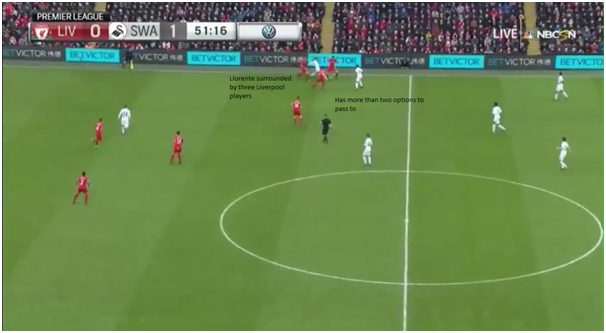
Llorente has the ball on the right flank, as Liverpool look to counter-press after having lost the ball in the final third. Three of Liverpool players are looking to win the ball back from the Spaniard and they might as well would have won it, if not for Swansea not committing numbers forward. Paul Clement’s men have just three men beyond the half-way line, allowing Llorente more options to pass to. Liverpool do press, but it comes to nothing because Swansea have enough numbers around the pressing unit to nullify the vigor of the press.
And being a goal up, they’ll be happy to keep the ball. As the press fails, Liverpool concede the second as soon as Leroy Fer switches the flank and Llorente headed in from a Tom Carroll cross. It was their inability to fend off a burly forward that cost them at this time, but it always started from the nullifying process around the midfield area.
This happens very often high up the pitch for Liverpool, when the opposition sits deep. That’s an area where the smaller side will obviously have more numbers in, considering the fact that they defend with two banks of four.
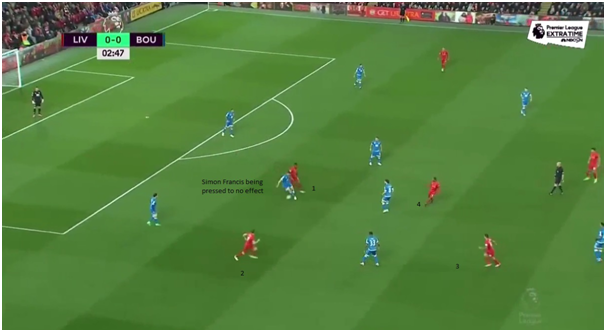
Above, Bournemouth are resorting to the same approach. They played a 4-4-2 formation, with the strikers offering help to the midfield whenever needed. As soon as Liverpool lose the ball, they start putting pressure on Simon Francis straightaway. There are as many as four players around him, but the number of Bournemouth teammates he has around him completely nullifies the threat of pressing.
This happens throughout the game. Some factors below would suggest why Liverpool struggle to break teams down, but this is primary reason for as to why the gegenpressing fails in its most fundamental aspect.
The instance below is a one from the recent goalless draw at Anfield, as James Milner missed a spot-kick in the second half to keep the score level. Claude Puel’s men are sitting deep in their own half, happy with allowing Liverpool to play in front of them. Divock Origi and Roberto Firmino are keeping Jack Stephens and Maya Yoshida occupied, but they don’t have any space to run into or any room to find around the position. It’s a classic example of a smaller team packing their midfield with numbers and denying the bigger side any space.
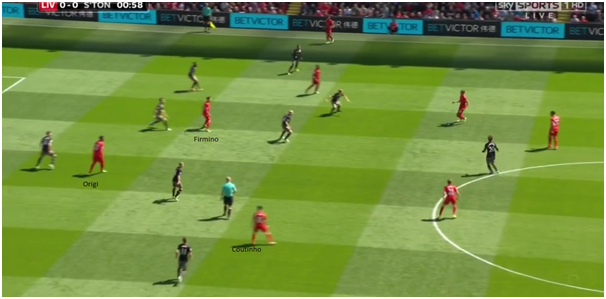
Notice that this is only the first minute of the game and Southampton resorted to the same approach, much like the other teams have throughout the games against Liverpool. Emre Can, who is currently on the ball, has only a single option to pass the ball through, as Manolo Gabbiadini’s pressing shadow is disallowing him from playing it to Lucas. Phil Coutinho happens to be the only player that can pass to, with the dynamic Brazilian having dropped in for support. A split second later though, Gabbiadini ended up dropping slightly deep himself, taking away Can’s only option- Coutinho.
As a result, the Reds lose the ball and Gabbiadini is off on the break.
This is something that happens throughout Liverpool’s games. They struggle to break sides down and one more deficiency that lets them down is width. When teams defend deep, it’s a necessity for the attacking side to make runs into the wide-channels and have players in the middle who can switch flanks and play long-balls to wide areas. Liverpool don’t seem to have both of these kinds of players, and these problems have escalated when Sadio Mane and Jordan Henderson were ruled out due to injuries.
And there was an instance in the game against Southampton itself, which suggested that Liverpool need more attacking intent in wide areas, if they want to breakdown deep defenses.
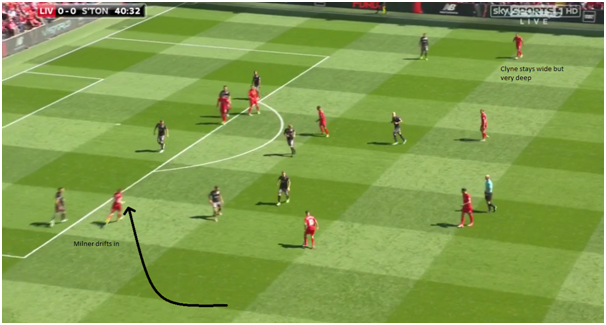
Five minutes from half-time, Southampton have allowed the Reds a lot of possession and have dropped in to make sure that Liverpool come forward. Coutinho is in possession, with almost all the players in central areas, looking to come short and play someone else in. Left full back James Milner, who should have been wide to stretch the defense, has drifted in too. One certainly can’t blame the Englishman considering left back isn’t his natural position. Nathaniel Clyne, Liverpool’s right-back is very deep when he has to push Sofiane Boufal back and occupy a more attacking position down his flank.
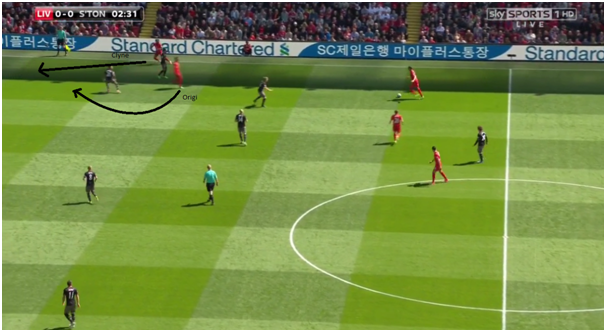
Early in the game, Clyne had bombed forward into the space that Origi’s movement had created, as shown above. It was a subtle move, but had opened up the Southampton backline to considerable effect. Clyne did fire in a cross, leading to the creation of a half-chance that Roberto Firmino couldn’t put away.
And all of the above things hardly happen against the top sides, who are playing a more open game and commit more numbers to attack. They don’t pack their midfield with numbers and instead of sitting deep, they keep a normal line and often have more possession as well.
Below, Tottenham have committed numbers forward to attack and are pressing the Reds in their own territory. Apart from Hugo Lloris, they just have two players in their own half and they are their centre-halves Toby Alderweireld and Jan Vertonghen.
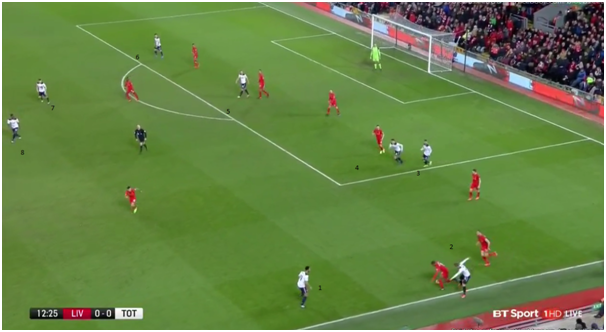
Due to this, Liverpool can play at their strengths. They can press high up the pitch or play on the break, which is good enough a smokescreen for their weaknesses when handed possession. And once they face a side from the top six, they can afford to play on the break and wreck havoc.
While, the weaknesses in open-play have been made rather obvious now, Liverpool’s inability to defend set-pieces is a worrying concern too. The Reds have let in as many as 12 goals from set-pieces this term (although, it’s surprising they didn’t concede from one against West Brom), with the defensive combinations yet to be sorted out. Dejan Lovren isn’t the most reliable centre-back in the world and nor is summer signing from Mainz- Ragnar Klavan. Joel Matip has been a crucial free capture from Schalke, but he is still in need of a proper partner at the back to shore things up.
And Jurgen Klopp will have to make sure that he signs at least two kinds of midfield players in the summer- a player who provides width in the absence of Mane and a ball playing central midfield player. If he doesn’t get them, his future may just come under stern scrutiny.
- Interview: Abneet Bharti on Indian footballers abroad - October 3, 2018
- Scout Report: Nicolo Barella | Cagliari’s Complete Midfielder - October 16, 2017
- Tales of a Football Scout: Giulio D’Alessandro - October 5, 2017
























































